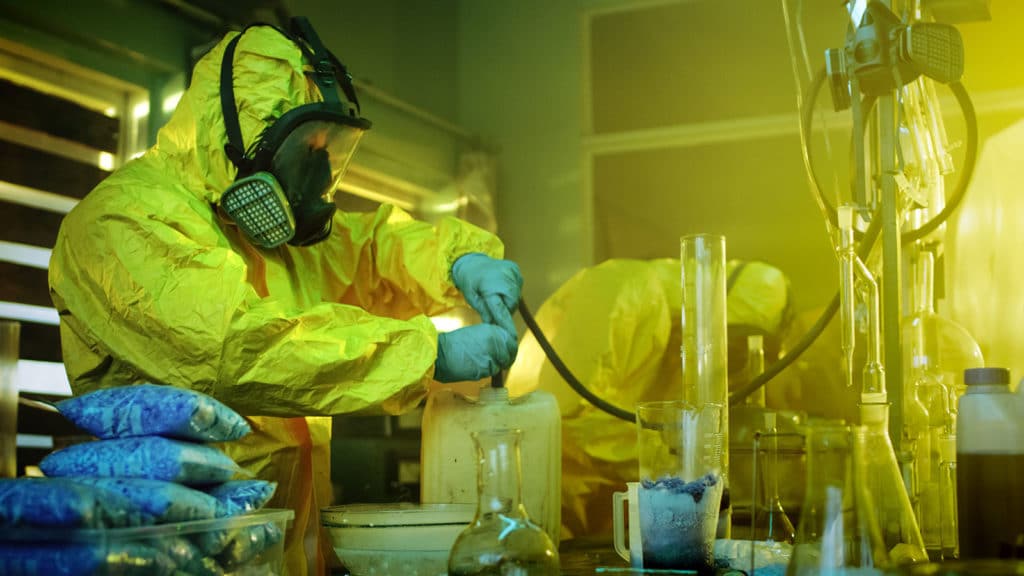Crystal meth is methamphetamine or meth in the form of shards or crystals. It is more potent than powdered methamphetamine and is created when the powder is dissolved in nail polish remover or rubbing alcohol. When the liquid evaporates, different sized shards or rocks of crystal meth are what’s left. Despite what’s seen on TV, pure crystal meth is odorless and colorless or may have a slight blue tint. After it’s prepared, the drug is then smoked or can be dissolved again and injected.
It is challenging to identify crystal meth on sight because it can resemble anything from rock candy to small wands of quartz or even broken glass.
Methamphetamine itself is a stimulant and is a Schedule II Drug. This means it does have a medical use but also has a high potential for being abused and puts the user at risk for addiction. When it’s used legally, it is sold as a prescription drug called Desoxyn. This drug is used to treat ADHD and obesity and can only be prescribed once.
How Crystal Meth is Used
When crystal meth is smoked, it causes a very intense euphoria called a rush. However, the rush is temporary, and to recapture it; the user takes the drug over and over during what’s called a meth “run.” Sometimes the binges are so frantic that the person doesn’t eat or sleep. The rush happens because the drug causes enormous amounts of a neurotransmitter called dopamine to flood the central nervous system. Dopamine is notable because it helps to regulate the brain’s pleasure centers.
After a while, the person builds up a tolerance to the drug. This means they need to take more and more of it to get the same effect. Eventually, they need to take the dug to feel healthy and to delay the onset of withdrawal symptoms. When this happens, the person is said to be addicted.
Effects of Crystal Meth
Since meth stimulates the nervous system, people who abuse it don’t sleep, sometimes have hallucinations and delusions and wild mood swings. They often don’t eat, are restless, and can become violent. The drug causes increased heart rate and breathing and spiking blood pressure, sometimes to the point where their cardiovascular system breaks down. This can lead to a stroke or heart attack. During a run, a person’s body temperature can become so elevated that it is a threat to their health.

Over time, the user can become anorexic because they don’t eat, and their muscles can start to break down. They can also have problems with their memory and develop the infamous “meth mouth.” A combination of dry mouth caused by the drug and neglect of dental hygiene can cause tooth decay and gum disease in a person who is addicted to meth. Eventually, the teeth turn black, rot, and crumble or fall out of the patient’s mouth. The condition is made even worse because some crystal meth addicts crave sweets when they are not using. Sweets by themselves can lead to tooth decay.
The effects of crystal meth are so brutal that they can even physically damage the user’s brain if they take it for a long enough time. The cells that make dopamine can be destroyed. In some cases, half the dopamine-producing cells in a crystal meth addict’s brain have been wiped out. Not only are dopamine-producing cells damaged, but serotonin-producing cells in the brain are also injured, sometimes even more grievously. Fortunately, the damage can be reversed if the crystal meth abuser stops the drug, though the reversal can take a long time.
Because of the destruction of these neurotransmitters in the brain, doctors believe that people who are addicted to meth are more at risk of contracting Parkinson’s disease, a usually autoimmune disease that attacks the nervous system.
The drug also endangers fetuses by making it more likely they will undergo a premature birth or have low birth weight. The good news is that full-term babies are not necessarily addicted to crystal meth, though they seem to be overly sensitive when they are newly born. Over time, this hypersensitivity disappears.
Crystal meth users are also more at risk for contracting or exacerbating diseases such as HIV and other blood-borne and body fluid borne diseases. The lack of judgment that comes with taking the drug makes them disregard the dangers of sharing dirty needles or engaging in unprotected sex.
Withdrawal
Meth withdrawal begins about 24 hours after the person stops taking the drug. The longer the person has been addicted to crystal meth, the more prolonged and more intense the withdrawal. Older people also have more intense symptoms than younger ones, as do people who are addicted to other drugs such as alcohol.
The symptoms of crystal meth withdrawal are:
- Anxiety
- Fatigue
- Depression
- Psychosis
- Cravings for the drug
- Intense hunger
These symptoms can last for about a week, though the anxiety can last for over a month.

